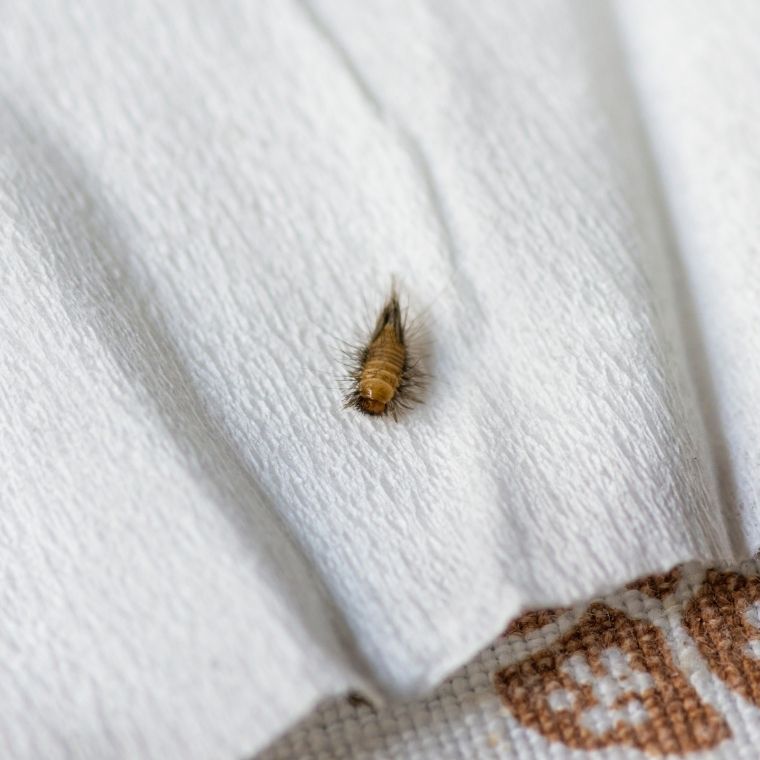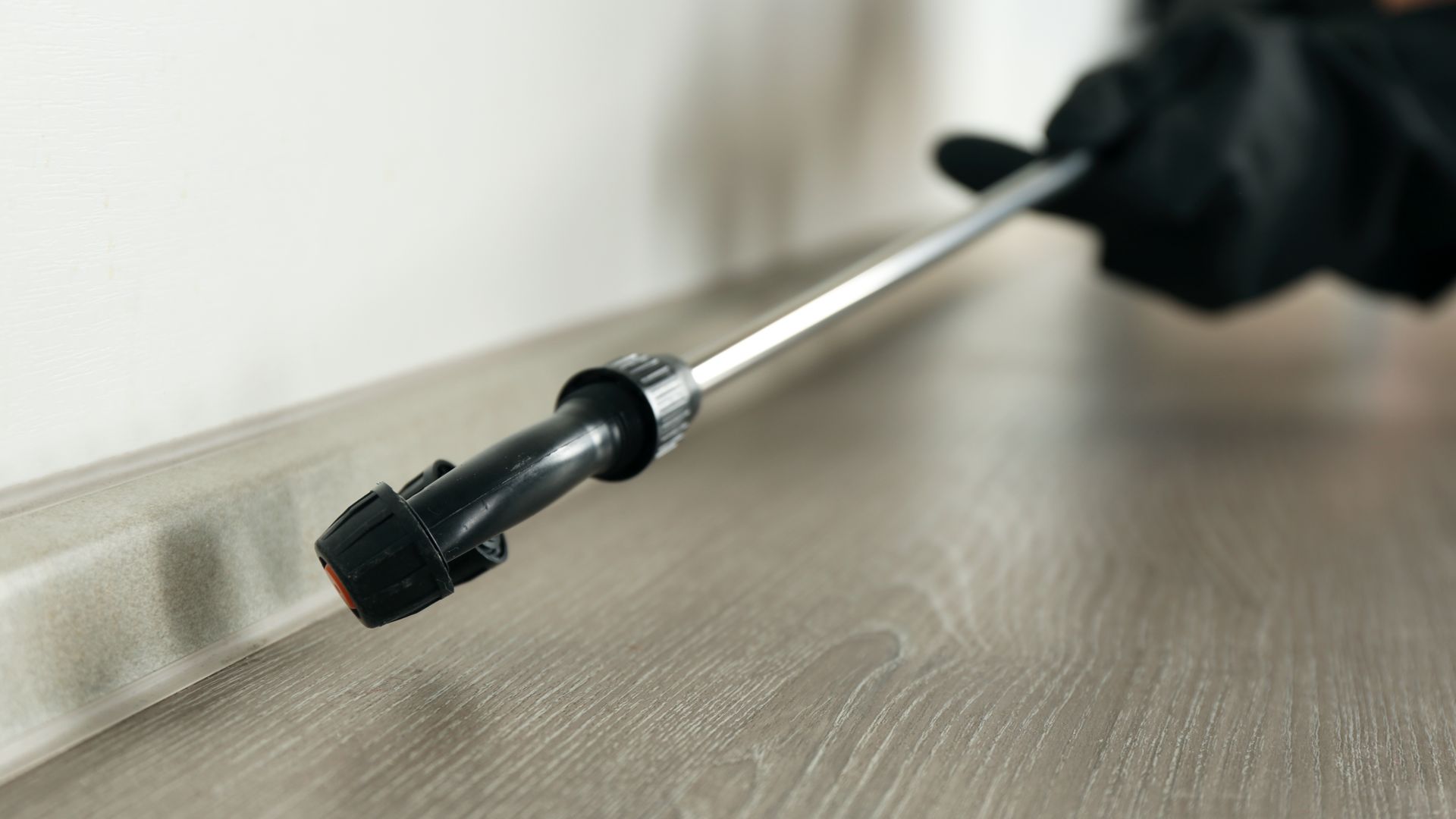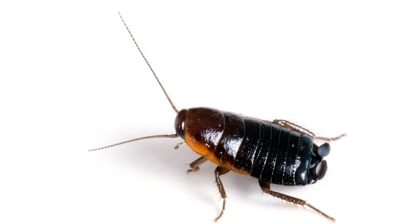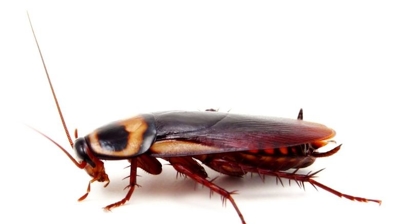
Carpet Beetle Larvae Control Services

Are Carpet Beetle Larvae Harmful?
Carpet beetle larvae, while small and seemingly harmless, can actually be quite damaging in a home or business environment. Here are some of the ways they might be considered harmful:
- Damage to Natural Fibers and Materials: Carpet beetle larvae feed on organic materials, particularly those of animal origin. Commonly affected items include wool, silk, fur, leather clothing, carpets, rugs, upholstered furniture, blankets, pillows, bedding, taxidermy specimens, and feathers. Their feeding can create holes, fraying, and thinning in fabrics, often starting subtly but becoming extensive if the infestation persists.
- Contamination of Stored Products: In addition to fabrics, larvae can infest stored products like grains, cereals, and dried goods, especially if the items have traces of animal products or are stored improperly. This can lead to food contamination and spoilage.
- Allergic Reactions and Skin Irritation: Larvae are covered in tiny, hair-like bristles called setae, which can become airborne and cause skin irritation, rashes, or even respiratory issues in sensitive individuals. Direct contact with these hairs can produce itchy, red bumps.
- Damage to Collections and Antiques: Carpet beetle larvae pose a serious threat to museums, collections, and antique items. They can feed on vintage clothing, historical documents with glue or parchment, leather-bound books, and ornamental items containing feathers or animal glue. This makes infestations particularly costly in environments with rare or irreplaceable items.
- Rapid Infestation Potential: A single female can lay dozens of eggs, which hatch into destructive larvae. If unnoticed, populations can grow quickly, leading to widespread damage across multiple areas of a home or business.
- Secondary Damage and Cleanup Costs: Even after larvae are gone, the damage they leave behind—holes, frayed textiles, shed hairs, and contamination—requires extensive cleaning, repair, or replacement of affected items.
Carpet beetle larvae are harmful not because they bite or sting, but because of their feeding habits, potential to contaminate materials, and the allergic reactions their hairs can cause. They are particularly dangerous to homes with natural fibers, antiques, or textile collections.
Carpet Beetle Larvae Control
Hiring our professional pest control for carpet beetle larvae is strongly recommended because these pests can be deceptively difficult to eliminate and can cause long-term damage if not addressed properly. Here’s why our professional intervention is the best approach:
- Accurate Identification: Carpet beetle larvae can easily be mistaken for other pests, such as clothes moths or carpet pests, especially in early infestations. Our professionals can correctly identify the species, which is critical because treatment strategies vary depending on the type of pest and the severity of infestation.
- Comprehensive Inspection: Our professionals don’t just treat visible areas; we perform a thorough inspection of hidden spaces where larvae thrive, including behind baseboards and moldings, inside closets and drawers, beneath carpets and rugs, in upholstered furniture, stored clothing, and fabric-based decor. This ensures the infestation is treated at its source rather than just superficially.
- Targeted, Effective Treatment: DIY treatments often involve surface cleaning or over-the-counter sprays, which may not reach larvae hiding deep in fibers or in inaccessible areas. Our pest control experts have access to professional-grade insecticides and techniques that can penetrate deep into fabrics and cracks, kill larvae and prevent them from pupating into adult beetles, and minimize risk to pets, children, and valuable materials through precise application.
- Prevention of Reinfestation: Carpet beetle eggs are tiny and easily go unnoticed, making reinfestation common if the root cause isn’t addressed. Our professionals can implement preventive measures such as treating surrounding areas where adults may lay eggs, advising on proper storage of clothing, textiles, and food, as well as recommending environmental adjustments (humidity, cleanliness) that deter carpet beetles.
- Protection of Valuables: Infestations often affect natural fibers, antiques, and collectibles, which can be costly to repair or replace. Our professional approach ensures minimal damage during treatment, guidance on protecting or salvaging valuable items, and documentation for insurance purposes if damage occurs.
- Time and Peace of Mind: DIY approaches can be time-consuming, frustrating, and frequently ineffective, often requiring repeated attempts. Our professionals provide a definitive plan, reducing stress and ensuring the infestation is managed quickly, safely, and efficiently.
Carpet beetle larvae may seem minor, but their hidden feeding habits, rapid reproduction, and potential damage to valuable textiles make our professional pest control the safest and most effective solution. Attempting to handle them alone often leaves infestations lingering and causing ongoing damage.
What Do Carpet Beetle Larvae Look Like?
Carpet beetle larvae have a very distinctive appearance that makes them recognizable if you know what to look for. Here’s what they look like:
- Length: Typically 1/8 to 1/4 inch (3–6 mm), though some species can grow slightly larger.
- Shape: Elongated, slightly flattened, and tapered at the ends. They resemble tiny, segmented worms or bristly caterpillars.
- Color: Color ranges from brown to reddish-brown, sometimes appearing golden or tan, depending on the species and age. Some larvae may appear patterned with lighter or darker bands along their body.
- Bristles or Hairs (Setae): Carpet beetle larvae are covered with fine, stiff bristles or hair-like structures, often giving them a fuzzy or spiky look. These bristles can cause skin irritation or rashes if handled.
- Segmented Body: Each larval segment is clearly defined. They have tiny legs near the front of their body, which are barely noticeable without magnification.
- Tail Tufts: Many species have longer hairs at the rear end, forming a brush-like tuft. This is especially noticeable in black carpet beetle and varied carpet beetle larvae.
- Movement: They are slow-moving and tend to stay hidden in dark, undisturbed areas such as under carpets and rugs, inside closets, drawers, or wardrobes, and beneath furniture or along baseboards
Recognizing these larvae early is crucial because they cause the damage to fabrics and stored products, whereas the adults mainly feed on pollen and are less destructive indoors.
Where Are Carpet Beetle Larvae Found?
Carpet beetle larvae are experts at hiding in dark, undisturbed, and often overlooked areas where they have access to natural fibers or stored food. Here’s where you’re most likely to find them in a home or business:
- Carpets and Rugs: They often feed on wool, silk, or other natural-fiber rugs. Look along edges, under furniture, or under heavy rugs where larvae are protected from disturbance.
- Upholstered Furniture: Inside sofas, chairs, and cushions, especially in seams and under padding. Fabric under furniture that rarely gets cleaned is a common breeding ground.
- Closets and Clothing Storage: Natural-fiber clothing (wool, silk, fur) in closets, drawers, or storage boxes. Jackets, sweaters, scarves, and hats that are stored for long periods are particularly vulnerable.
- Bedding and Linens: Blankets, comforters, sheets, and pillows—especially older or woolen items. Rarely washed linens create a suitable environment for larvae.
- Stored Fabrics and Textiles: Fabric remnants, sewing materials, or old costumes in storage. Antique or heirloom textiles that are stored without protection are highly susceptible.
- Dark, Undisturbed Corners Baseboards, cracks, and crevices where dust and lint accumulate. Behind radiators, picture frames, and wall hangings.
- Animal Products and Taxidermy: Feathers, furs, hides, and mounted specimens in collections or displays. Pet bedding made of natural fibers can also be affected.
- Food Storage (Occasionally): While less common than fiber infestations, some larvae can infest dried food products containing animal protein, like grains, cereals, or dried pet food, particularly if packaging is damaged.
Larvae thrive in dark, warm, and undisturbed locations where they have access to natural fibers or animal products. Regular cleaning, vacuuming, and inspection of stored textiles can help prevent infestations from spreading.

Hear From Our Happy Customers
-
"Great Communication"
Tech was on time, communication was great, and he accommodated my needs.
- Alonzo W. -
"Professional & Considerate"
I’m pleased with Miche services. Jarvis came today. Professional and considerate. Thank you!
- Judy B. -
"Very Knowledgeable"
The tech that arrived was courteous, professional, and very knowledgeable. He was Great.
- Uerial I. -
"Exceeds Expectations"
I can’t say enough positive things about this company... The tech that came out, Jarvis went above and beyond my expectations. Thank you guys, I will continue using your services.
- Jake M. -
"Fantastic & Patient"
Jarvis was fantastic and patient. He answered my questions with an in-depth explanation and addressed all of my areas of concern. Would love for him to be my assigned tech going forward. Well done!
- Yonnette M. -
"Wonderful Service"
Wonderful service. Jarvis is great. Took care of everything I needed. Thank you!
- Henry P.



